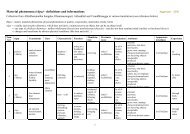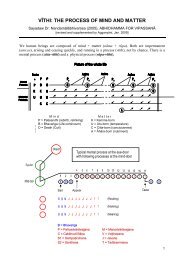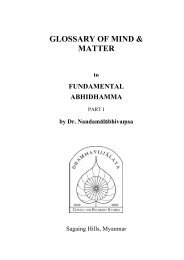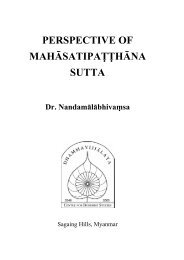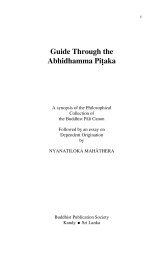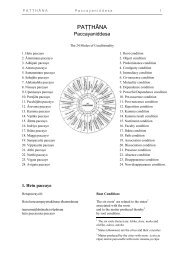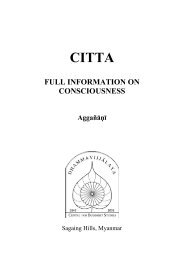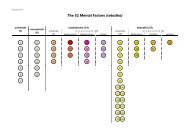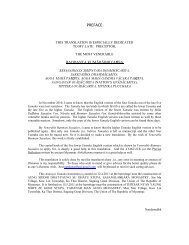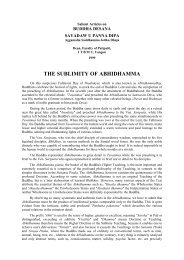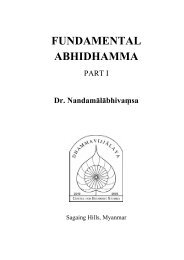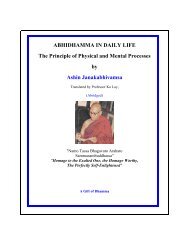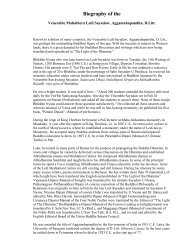Process of Consciousness and Matter - Abhidhamma.com
Process of Consciousness and Matter - Abhidhamma.com
Process of Consciousness and Matter - Abhidhamma.com
Create successful ePaper yourself
Turn your PDF publications into a flip-book with our unique Google optimized e-Paper software.
I. CONSCIOUSNESS AND ITS FACTORS<br />
(Etena cintetīti cittaṁ). Finally, citta as activity is simply “thinking”<br />
(Cintanamattaṁ cittaṁ). A question arises: how is it that the<br />
<strong>com</strong>mentators came to define citta in these three ways The answer is<br />
that the idea <strong>of</strong> a soul or atta (ātman) is deeply rooted in the human<br />
mind. For this reason, the ancient religious thinkers have supported<br />
the idea <strong>of</strong> a soul, ātman or atta. In their opinion, it is the atta or ātman<br />
that is the thinker <strong>of</strong> thoughts, the feeler <strong>of</strong> feelings <strong>and</strong> the doer <strong>of</strong><br />
deeds. In the view <strong>of</strong> the <strong>Abhidhamma</strong>, however, the existence <strong>of</strong><br />
ātman is false. In the <strong>Abhidhamma</strong> it is the citta (consciousness) itself<br />
that cognises objects <strong>and</strong> all other mental states arise together with<br />
citta. Citta itself is equated with thought.<br />
The first <strong>and</strong> second definitions prove that no ātman or “self” exists. It<br />
is citta itself that thinks. It can therefore be said that there is no<br />
thinker, only thinking.<br />
The characteristic <strong>of</strong> citta is the knowing <strong>of</strong> an object. The<br />
function <strong>of</strong> citta is to be forerunner <strong>of</strong> the mental factors, in that it<br />
presides over them <strong>and</strong> is ac<strong>com</strong>panied by them. It manifests in the<br />
meditator’s mind as a continuity <strong>of</strong> processes. However,<br />
consciousness cannot arise on its own. Rather it depends on mental<br />
factors <strong>and</strong> material phenomena. Citta has a single characteristic as the<br />
cognising <strong>of</strong> an object, a characteristic that remains the same in all its<br />
diverse manifestations. What we ordinarily think <strong>of</strong> as consciousness<br />
is really a series <strong>of</strong> cittas, momentary acts <strong>of</strong> consciousness, occurring<br />
in such rapid succession that we cannot detect the discrete moments,<br />
which are <strong>of</strong> diverse types. The <strong>Abhidhamma</strong> not only distinguishes<br />
between the types <strong>of</strong> consciousness but, more importantly, it also<br />
classifies them as a unified <strong>and</strong> closely interwoven whole.<br />
Classification <strong>of</strong> <strong>Consciousness</strong><br />
Classification by way <strong>of</strong> Plane<br />
The <strong>Abhidhamma</strong> classified consciousness according to several<br />
principles. Classifications by way <strong>of</strong> planes <strong>of</strong> existence, <strong>and</strong> by<br />
nature or kind, play very important roles in the <strong>Abhidhamma</strong>. There<br />
12



